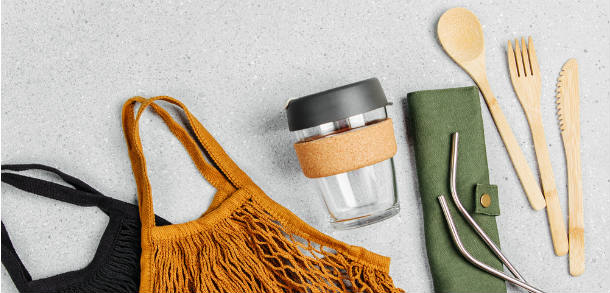Sunday 1 March 2020
The terms biodegradable, compostable and eco-friendly are often used to promote products as being a better option for the environment. But what do they actually mean?
What does biodegradable mean?
Biodegradable means an item can be broken down into smaller pieces naturally under certain conditions. However, this could mean it takes months to break down, or it may take hundreds of years and the result may or may not be harmful to the environment. Almost all things are biodegradable, however not all of them break down into natural products, plastic for example will break down into smaller pieces called microplastics, which can be harmful to the environment.
What does compostable mean?
Compostable items can fully break down and produce no harmful products as a result. Under a suitable environment for composting this is usually expected to happen in less than a year. Many items will break down within this time in a home compost bin such as raw fruit and vegetable peelings, whereas other items may require industrial composting such as cooked foods and dairy products.
What does eco-friendly mean?
Eco-friendly products often refer to the ingredients used rather than how the item will break down over time. The Cambridge dictionary meaning defines eco-friendly as “designed to do little or no harm to the environment”. However, this term is often used to describe products which are less harmful than other similarly available products, such as cleaning products.
What products are better for the environment?
The best environmental options
- Choose items without packaging. If you can avoid purchasing products in the first place, that’s often the best option. However, where this is not possible, consider buying items with less packaging and products that use more sustainable materials such as paper or cardboard.
- Purchase pre-loved. Buying items second-hand often means you’ll get a bargain, but also extends the useful life of a product, reducing the environmental impact.
- Use reusable items. Opting for reusable items that can be used over and over again, is often the next best option. This could be a reusable coffee cup or water bottle, or container used to refill household foods and products.
- Choose products with sustainably sourced natural ingredients. This is not always easy but buying a bar of soap made locally and using sustainable ingredients will help to reduce your carbon footprint.
Good environmental options
- Opt for recyclable items. Where you cannot use reusable, choose items that can be recycled in your kerbside collection, such as paper, cardboard, tin or plastic bottles. Although energy is used in the production and distribution, this ensures that a resource is not wasted, but used again and again.
- Compost your food and garden waste at home. Items such as food and garden waste can be naturally composted and is usually the best option as it reduces transportation and also provides you with a great soil improver.
Items to be cautious of
- Be cautious of items branded compostable. Many products are now branded as compostable, such as compostable coffee cups. These types of products can only be composted under industrial processes, something that requires energy and is often unavailable. If a compostable item is thrown in the bin, the environmental impact could be similar to that of any other single-use coffee cup.
Options to avoid where possible
- Single-use products are best to avoid. Although some single-use items may be recyclable such as plastic bottles, many can only be thrown in the general rubbish bin, such as single-use coffee cups, plastic cutlery and wipes. There are lots of great reusable alternatives that can replace the need for these items.
- Unrecyclable products. It’s important to ensure an item or product is protected so that it either lasts longer, such as food products, or it is protected from damage during transportation. This could be anything from electrical items and furniture, to household goods. However, where possible try to avoid products with excessive or non-recyclable packaging.
Find out more about plastic
Ideas to help reduce your plastic
Plastic recycling in Essex
Tips to improve your recycling

